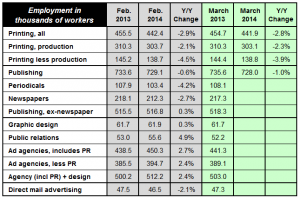Commentary & Analysis
Employment Report Stays Mixed
Last Friday’s unemployment report had something for everyone.
Last Friday’s unemployment report had something for everyone. January and February payrolls were revised up, and March payroll employment increased by +192,000. The unemployment rate remained at 6.7%. Last year it was at 7.5%.
The household survey was more interesting. Employment increased by +476,000 workers, a very good number, and the labor force increased by +503,000, also a very good number. It is likely that there were two factors that played roles in the increases. The first was further delays in the implementation of the Affordable Care Act. Second, the expiration of long-term unemployment benefits. Though it is politically difficult to refuse to approve the extension of unemployment benefits, academic research has shown that many workers will stay on unemployment as long as possible. To oversimplify, about one third of unemployed workers find work quickly. Another third find work near the time of their payment expirations. Everyone else is somewhere in between. Sometimes unemployment benefits allow workers to remain at home for family duties while another member of the household continues to work. The reasons are not always nefarious, but matters convenience. Economists worry that unemployment extensions cause workers to be "picky" in their selection of next jobs. In the long run, the longer that workers remain unemployed, the more likely it is that their skills deteriorate. Also, it is in the best interest of the economy to have workers employed quickly as a means to adapt to new technologies and to reallocate labor to where it is most needed.
This brings up another topic, which is part time employment. Despite the clatter that part time employment is rising, it is at a typical level as a total percentage of the workforce. That is, if you take part time work as a percentage of the total workforce there is nothing odd about the data.
What is odd is how much it increased in this particular report. Remember that +476,000 increase in employment in the household survey? There was also an increase in part time employment of +414,000. It is tempting to say that the economy added only +62,000 full time jobs by combining these two figures, but they are not comparable. Part time employment is of the entire workforce of almost 146 million people. The workforce is very dynamic, and it’s not really possible to say how many of these part time workers were new to the employed workforce or were previously full time workers with newly reduced hours.
Other aspects of the report that should be of concern are that there was a -60,000 decrease in new entrants to labor force, giving credence to the analysis that much of the surge in employment was from those with expired unemployment benefits, and that the number of new entrants to the workforce is down -150,000 compared to this time last year.
Other key data that made this report less positive is that compared to March 2013 more than 1.1 million people left the workforce, but that has been getting better recently. There are 1.2 million fewer unemployed workers than last year, meaning that there were many unemployed who just left the workforce. Since January, the number of unemployed workers has increased by 250,000, and is now just under 10.5 million.
The chart below shows how employment has changed in the printing and content creation industries (click to enlarge).
About Dr. Joe Webb
Dr. Joe Webb is one of the graphic arts industry's best-known consultants, forecasters, and commentators. He is the director of WhatTheyThink's Economics and Research Center.
Video Center

WhatTheyThink is the official show daily media partner of drupa 2024. More info about drupa programs
© 2024 WhatTheyThink. All Rights Reserved.









